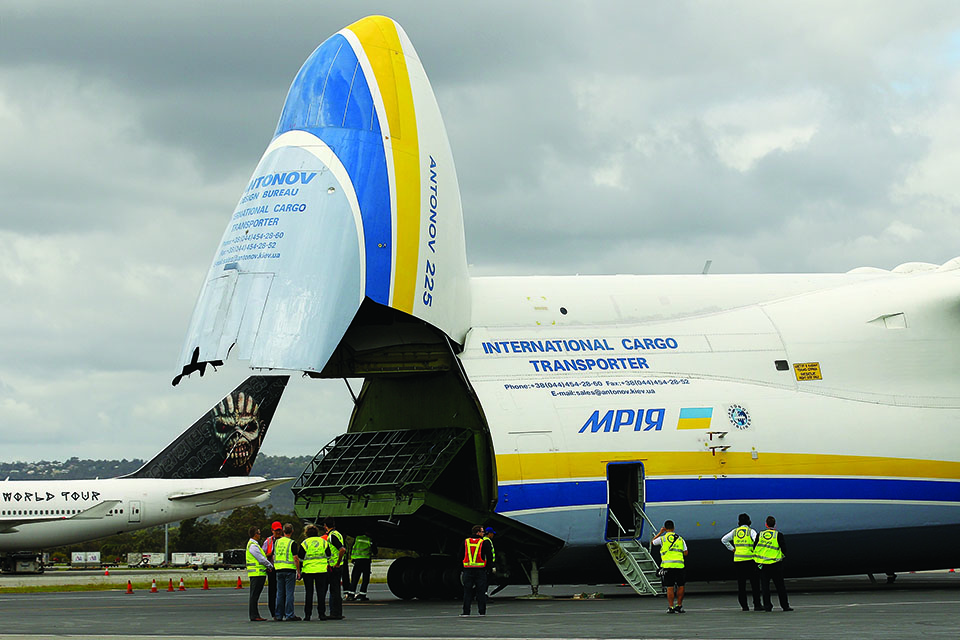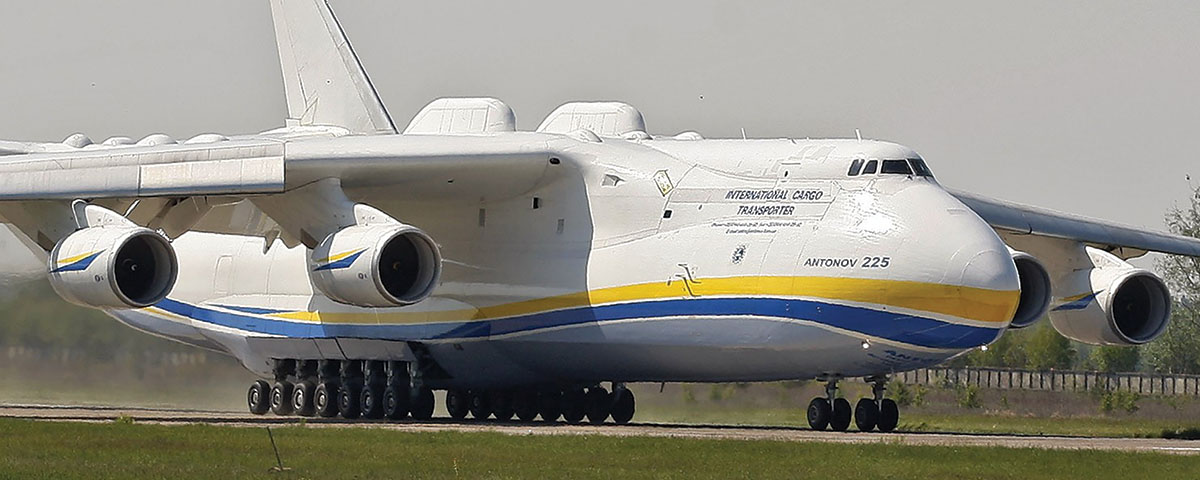The Antonov State Company outdid itself at thinking big with the An-225 Mriya, the world’s largest airplane.
There’s no getting around the fact that Russia is a big country. Perhaps that explains why Russians seem to have always been obsessed with big airplanes. Ever since 1914, when Igor Sikorsky set a world altitude-with-payload record with his giant Ilya Muromets, the world’s first four-engine production airplane, Russians have been building airplanes of ever greater size and payload capacity.
The latest in the line of Russian giants, the Antonov An-225, also known as the Mriya (“dream”), is truly in a class by itself. In comparison with the Airbus A380 jumbo-jet airliner, the An-225 has a 30-foot greater wingspan, 38-foot longer fuselage and a nearly 18,000-pound heavier maximum takeoff weight. It has set 240 world records, including transporting the heaviest cargo (253 tons), the heaviest single piece of cargo (186.7 tons) and the longest single piece of cargo (138 feet).
Company founder Oleg Antonov got his start the same way as a lot of aspiring aircraft designers in the early Soviet era, by joining the Organization of Friends of the Air Force and designing a glider. During much of the 1930s, Soviet pilots were required to do their primary training in gliders. Producing gliders remained Antonov’s chief concern until 1938, when an instructor managed to defect in one. After that glider training was terminated, the glider clubs were abolished and Antonov’s glider factory was shut down.
Antonov continued to work in the aviation industry during World War II, collaborating with Aleksandr Yakovlev on his fighters. He also designed military assault gliders, among them the bizarre A-40 Krylya Tanka, or “tank wings,” which consisted of a set of biplane wings and a tail attached to a T-60 light tank. The combination is said to have flown successfully on at least one occasion, but the Soviets abandoned the idea in 1942 when they realized they didn’t have an airplane powerful enough to tow it the required distance. Following WWII, Antonov specialized in utility, passenger and cargo aircraft, including the An-2 biplane, of which some 18,000 were built, and the An-22 Antei, the largest airplane in the world when first flown in 1965 and still the world’s largest turboprop.
Although Antonov died in 1984, his An-225 remains a fitting memorial to an airplane designer who liked to think big. First flown in 1988, it was designed to transport outsize loads for the Soviet space program—in particular the Buran (“snowstorm”) reusable space vehicle, the Soviet version of the Space Shuttle. The An-225 turned heads when it carried the Buran to the 1989 Paris Air Show. At 93,000 pounds, the Buran was no minimus, but it looked like a Piper Cub while perched atop the An-225’s enormous fuselage.

The An-225 was developed from an earlier Antonov giant, the An-124 Ruslan cargo plane—the world’s largest airplane when first flown in December 1982, with a maximum takeoff weight of 893,000 pounds, 75,000 pounds greater than that of the Lockheed C-5 Galaxy. The An-225’s fuselage is similar to the An-124’s, retaining its cross-section and nose loading door, but it has been lengthened by 50 feet, to 267 feet, with the rear loading ramp eliminated to save weight. Two additional sets of main landing gear were also installed, for a total of seven pairs of twin main wheels on each side of the fuselage. The An-225’s wings are also similar to the An-124’s, but their span was extended 50 feet to 290 feet and they carry two additional Lotarev D-18T jet engines—each generating about 44,000 pounds of thrust—for a total of six.
Loading points atop the fuselage enabled the An-225 to carry the Buran or other outsize loads (the loading points are covered with streamlined fairings when not in use). A revised twin-fin tail keeps the rudders clear of the aerodynamic turbulence generated when carrying loads atop the fuselage.
Though the Buran program was canceled at the end of 1989 due to a lack of funding, its designated transport still flies today. After the breakup of the Soviet Union, the Antonov State Company’s factory, and the An-225, came under the jurisdiction of the newly independent state of Ukraine. The Mriya (actually a Ukrainian word) remains the only An-225 ever built, although a second partially completed aircraft is sitting at the Antonov factory. In September 2016, the Chinese and Ukrainians reached an agreement whereby the Aviation Industry Corporation of China would complete the unfinished An-225. Its completion is slated for 2019, after which plans call for the aircraft to be produced under license at the AICC’s factory in China, though many obstacles remain to be overcome.
As it is, this single giant transport has remained in demand to carry heavy and outsize cargo over long distances all around the world. The Mriya can haul 200-ton loads nonstop over intercontinental distances and transport up to 250 tons over short stages. Among other missions, it has been used to deliver emergency supplies to Haiti after the 2010 earthquake and to Japan after the 2011 earthquake and tsunami.
This article originally appeared in the March 2017 issue of Aviation History. Subscribe here!





